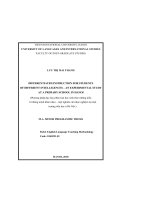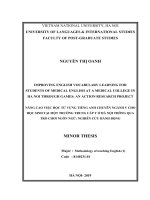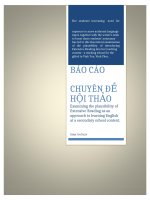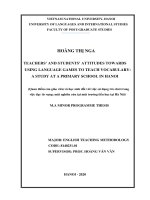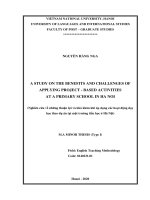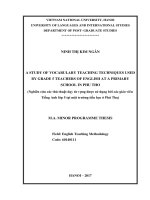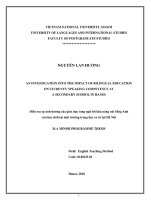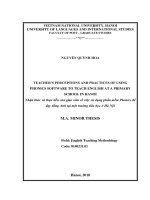Teacher’s perceptions and practices of using phonics software to teach english at a primary school in hanoi
Bạn đang xem bản rút gọn của tài liệu. Xem và tải ngay bản đầy đủ của tài liệu tại đây (1.04 MB, 87 trang )
VIETNAM NATIONAL UNIVERSITY, HANOI
UNIVERSITY OF LANGUAGES AND INTERNATIONAL STUDIES
FACULTY OF POST – GRADUATE STUDIES
----------------**0**----------------
NGUYỄN QUỲNH HOA
TEACHER’S PERCEPTIONS AND PRACTICES OF USING
PHONICS SOFTWARE TO TEACH ENGLISH AT A PRIMARY
SCHOOL IN HANOI
Nhận thức và thực tiễn của giáo viên về việc sử dụng phần mềm Phonics để
dạy tiếng Anh tại một trường tiểu học ở Hà Nội
M.A. MINOR THESIS
Field: English Teaching Methodology
Code: 8140231.01
Hanoi, 2018
VIETNAM NATIONAL UNIVERSITY, HANOI
UNIVERSITY OF LANGUAGES AND INTERNATIONAL STUDIES
FACULTY OF POST – GRADUATE STUDIES
----------------**0**----------------
NGUYỄN QUỲNH HOA
TEACHER’S PERCEPTIONS AND PRACTICES OF USING
PHONICS SOFTWARE TO TEACH ENGLISH AT A PRIMARY
SCHOOL IN HANOI
Nhận thức và thực tiễn của giáo viên về việc sử dụng phần mềm Phonics để
dạy tiếng Anh tại một trường tiểu học ở Hà Nội
M.A. MINOR THESIS
Field: English Teaching Methodology
Code: 8140231.01
Supervisor: Dr. Vũ Thị Thanh Nhã
Hanoi, 2018
DECLARATION
I hereby certify that the thesis entitled
Teacher’s perceptions and practices of using Phonics software
to teach English at a primary school in Hanoi
is the result of my own research for the Degree of Master of Education at the
University of Languages and International Studies, Vietnam National University,
Hanoi. I confirm that this thesis has not been submitted for any other degrees.
Signature:
Nguyen Quynh Hoa
Date:…………………
i
ACKNOWLEDEMENTS
First of all, I would like to express my deepest gratitude to my thesis supervisor Dr.
Vu Thi Thanh Nha for her encouragement, invaluable guidance, and support
throughout the process of this research. Without her assistance and contribution, this
thesis would never have been completed.
I am also indebted to three teachers who took part in the program, spent time
completing my interviews and allowed my observations. The information collected
was a precious source of data to make the research fruitful.
Lastly, I would like to express my gratitude to my family for their support and
encouragement from the beginning to the end of the research.
ii
ABSTRACT
The study examined teachers‟ perceptions of using of Phonics software and their
practices in classroom at a primary school in Soc Son district. Three teachers were
invited to join this research. The study was carried out with two data collection
techniques: interview and observation.The findings indicated that teachers had both
positive and negative perceptions towards the use of Phonics software. All teachers
indicated that the program could improve learners‟ overall language skills such as
developing students‟ language skills (listening, speaking, reading, writing),
developing learners‟ communication skills and vocabulary knowledge as well as
creating a relaxing environment. However, some teachers confirmed that Phonics
software was successful in meeting young learners‟ needs and characteristics while
other teachers pointed out some unsuitable features for the students. The research
revealed some major problems in the application of Phonics software such as
teaching multi-level students, shortage of time, and teachers‟ implementations. At
the end of the research, I gave some recommendations to improve Phonics software
and the quality of teaching and learning.
iii
TABLE OF CONTENTS
Page
Declaration
i
Acknowledgements
ii
Abstract
iii
Table of contents
iv
List of abbreviations
viii
List of figures and tables
viii
PART ONE: INTRODUCTION
1. Statement of the problem
1
2. Aims and objectives
1
3. Research questions
2
4. Scope of the study
2
5. Method of the study
2
6. Significance of the study
3
7. Organization of the study
3
PART TWO: DEVELOPMENT
CHAPTER ONE: LITERATURE REVIEW
1.1. Computer assisted language learning (CALL)
5
1.1.1. What is CALL ?
5
1.1.2. Impacts of CALL on language learning and teaching
5
1.1.3. Models of CALL
8
iv
1.2. The criteria for selecting CALL software program for young learners 10
1.3. Perception
12
1.3.1. Definition of teachers’ perceptions
12
1.3.2. Relationship between teachers’ perceptions and practices
13
1.3.3. Some theoretical frameworks of teachers’ perceptions and
15
practices
1.3.4. Previous studies on teachers’ perceptions of CALL
17
CHAPTER TWO: THE DESIGN OF PHONICS AND AN OVERVIEW
OF THE USE OF PHONICS AT A PRIMARY SCHOOL
2.1. An overview of the use of Phonics at a primary school
21
2.2. The context of a primary school
25
2.3. The design of Phonics software
25
CHAPTER 3: METHODOLOGY
3.1. Survey research
31
3.2. Data Collection
31
3.2.1. Observation
32
3.2.2. Interview
33
3.3. Data analysis
34
3.4. Participants of the study
36
3.5. Procedure
36
3.5.1. Teachers’ interviews
36
3.5.2. Classroom observations
37
3.6. Difficulties encountered
37
v
3.7. Ethics
37
CHAPTER FOUR: DISSCUSION OF THE FINDINGS
39
4.1. Finding from interviews
39
4.1.1. Teachers‟ perceptions of Phonics software
39
4.1.1.1. Meeting students’ needs and characteristics
39
4.1.1.2. Improving young learners’ overall language skills
41
4.1.2. The problems in the application of Phonics software
42
4.1.2.1. Teachers’ difficulties in implementing Phonics software
42
4.1.2.2. Teachers’ needing supports
43
4.1.2.3. Teachers’ recommendations to improve Phonics software
44
4.2. Finding from classroom observations
45
4.2.1. The reality of teachers' class teaching
45
4.2.2. Students’ engagement
46
4.3. Discussions of the findings
47
4.3.1. Relationship between teachers’ positive perceptions of Phonics
47
software and classroom observations
4.3.2. Relationship between teachers’ negative perceptions of Phonics
48
software and classroom observations
4.3.3. Problems in the application of Phonics software
50
PART III – CONCLUSION AND RECOMMENDATIONS
1. Summary of the study major points
53
1.1. Summary of the study
53
1.2. Conclusion
53
vi
2. Implications
54
3. Limitations of the study and suggestions for further research
54
REFERENCES
56
APPENDICES
I
APPENDIX A
I
APPENDIX B
II
APPENDIX C
XI
APPENDIX D
XII
vii
LIST OF ABBREVIATIONS
CALL: Computer-assisted Language Learning
EFL : English as a foreign language
LISTS OF TABLES AND FIGURES
No
Title
Page
Table 1
The criteria for selecting computer software
10
Table 2
Pronunciation teaching approaches
23
Table 3
Participants' profile
39
Figure 1
Teachers cognition elements
16
Figure 2
Teacher-student perceptions and the quality of learning
16
outcomes
Figure 3
Taxonomy of research data collection techniques
32
Figure 4
The inductive logic of research in a qualitative study
35
viii
PART I – INTRODUCTION
1. Statement of the problem and rationale of the study
Recently, the question of using technology at elementary schools are raised.
Because technological and software methods to teach English are very different
from the more traditional methods used. They are not only modern tools but also
new forms and methods approaches of teaching. In recent years, some of the
countries such as Indonesia, India, Thailand, Singapore, China, Korea, Malaysia
and Vietnam are using an English Language teaching software named Phonics. In
these countries this software is used in a way that it assists English language
teaching process at schools.
In Vietnam, Phonics was first applied in some primary schools in Hanoi and Ho Chi
Minh city in 2008 and has recieved different opinions from the administrators,
teachers and students. At the beginning of 2009, many primary schools in Soc Son
district started using Phonics-an English software-in English teaching and learning
with the belief that Phonics would lay the foundation to improve English learning
and create a supportive environment for children from the early age. Teachers play
a significant role in learning style and teaching strategies.
Teachers‟ perceptions towards the use of software technology in language teaching
have been investigated by many researchers (Choy and Ling Ng, 2015;Thompson,
2015;Mollaei & Riasati, 2013;Almekhlafi & Almeqdadi, 2010). However, there is
limited research into the application of these software programs in primary school
contexts and the ways in which they give feedback to students (Neri, Cucchiarini &
Strick ,2001;2002;2003). The research project reported in this thesis attempted to
provide some data to bridge this gap. It is the reason that I decided to conduct the
study “Teacher’s perceptions and practices of using Phonics software to teach
English at a primary school in Hanoi”.
2. Aims and objectives of the study:
1
The aims of the study are as follows :
To explore what English teachers perceive Phonics software.
To discover how teachers utilize Phonics software to meet the students‟ needs and
characteristics.
3. Research questions
In order to achieve the aims of the study, the following research questions were
raised
(1)What do teachers perceive Phonics software ?
(2)How do teachers use the software in the classroom?
4. Scope of the study
The present study operates within the following scopes:
The research is delimited to three English teachers in the context of classroom.
Due to the limit of the study and constraint of time, my thesis will focus on the
teachers‟ perception towards Phonics software and their practices to more fully
understand.
5. Method of the Study
Qualitative method was chosen as a research method applying for this study.
In order to identify teachers‟ perceptions of Phonics software and their actual
practices, two research instruments were used. These were interviews and class
observations.
The interviews were conducted three English teacher participants. I reported the
teachers‟s perceptions of Phonics software and their problems in the application of
Phonics software in teaching.
2
Classroom observationswere used to reveal the behaviours, level of engagement,
and interactions between the teachers with Phonics program and the students with
this software.
6. Significance of the study
The research, first of all, will provide further information of Phonics software for
young learners, to see whether it satisfies students‟ needs and characteristics
through the instructional design.
The understanding of teacher‟s perspectives of Phonics will be one way to get
feedback from teachers for this software. Accordingly, they would use and be aware
of the strong and weak points of this product.
The findings from this study can explore the teachers, the students and the
admistrators‟ beliefs of using Phonics software in teaching and learning. I hope that
it would bring them positive attitudes towards adopting technology for language
learning.
7. Organization of the Study
This study consists of three main parts: introduction, development and conclusion.
The introduction presents the rationable, the aims and objectives, research
questions, scope, method, significance and design of the study.
The development comprises four chapters
Chapter 1 provides a review of the literature, including a theoretical
framework focusing on learning and teaching theory, also provides research
of issues related to teachers‟ perceptions.
Chapter 2 details the setting of the study in which all the language items
displayed in the software are speciffically defined and the context of the
study are also described.
Chapter 3 describes the methodology through a description of the qualitative
approach. It includes the study participants, instruments, the procedure and
3
data analysis. In addition, difficulties encountered and ethics are mentioned
too.
Chapter 4 is where the data are presented, the findings and discussion come
up with the basis of the evaluation in the previous chapters.
The conclusion offers a summary of the study, limitations and suggestions for
further study.
4
PART II – DEVELOPMENT
CHAPTER 1: LITERATURE REVIEW
This chapter reviews a number of relevant concepts and studies for the present
study.
The first begins with some issues regarding Computer- Assisted Language Learning
(CALL) : definition of CALL, impacts of CALL on language learning and teaching,
model of CALL. Then, the characteristics of young learners are analysed to provide
a basic framework of language instructional designs. Next, the concept of teachers‟
perceptions, some theoretical frameworks of teachers‟ perceptions and practices, the
relationship between teachers‟ perceptions and practices, and the previous studies
on teachers‟ perceptions of CALL are presented.
1.1. Computer-Assisted Language Learning (CALL)
1.1.1. What is CALL?
According to Maley (1989) CALL is the term most commonly used by teachers and
students to describe the use of computers as part of a language course. Hardisty and
Windeatt (1989) give a more detailed definition. Accordingly, CALL is traditionally
considered as a method of “presenting, reinforcing and testing” (p.5) particular
language items in which the learner is first presented with a rule and some
examples, and then answers a series of questions which test her/his knowledge of
the rule and the computer gives appropriate feedback and awards a mark which may
be stored for later inspection for the teachers and reference for the learners.
1.1.2. Impact of CALL on language learning and teaching
Many previous studies indicated that technology has a positive influence in
language learning (Afrin ,2014;Hani,2014;Jones and Fortescue ,1987;Beatty,
2003;Healey ,1999;Hanson-Smith, 2000;Pennington, 1989;Neri, Mich, Gerosa and
5
Giuliani ,2008;Lin, Winaitham, & Saitakham, 2008;Cunningham and Redmond,
2008;Blake, 1998;Beauvois, 1997 ).
For example, Afrin (2014) suggests that technology use can help students take
ownership of their learning, make them autonomous and confident in their learning
and enable introverted students to interact more freely.
In addition, CALL has a lot of effects on language learning in terms of methods.
This gives teachers much flexibility in their teaching practices. In traditional
teacher-centered classrooms the role of the students is simply to listen and follow
the instructions of the teacher and the teachers‟ role is to give instruction, to ask
questions, to initiate actions and interactions, and to set limits on activity times. In
addition, teachers are responsible for giving the facts and defining important ideas.
The activities held in the classrooms are also generally within the teachers‟ domain
(Sandholtz et. al., 1990). The use of computer software programs as supportive
materials in classrooms provides new opportunities for applying an audio-visual
approach, cognitive approach, and communicative approach. For example, while
applying an audio-visual approach, pronunciation is stressed, lessons with dialogues
are utilized, and mimicry and memorization are used. In a cognitive approach, the
instruction is often individualized, so students are responsible for their own
learning. While using a communicative approach, the goal of language teaching is
learner ability to communicate in the target language (Celce-Murcia, 2001). These
approaches embedded in software programs support new learning skills more
effectively than classical methods for language learning.
Additionally, Hani (2014) also indicates some advantages of using technology in
Teaching English as a Foreign Language (TEFL). They are: increasing students
motivation, providing students with immediate feedback, providing more fun,
requiring less time and effort in the classroom, developing language skills, fostering
individualization, providing more opportunities to learn outside the classroom. He
6
also illustrated that the implementation of technology leads to the integration of the
four linguistic skills (listening, speaking, reading and writing).
Similar findings were also reported by Beatty (2003).The researcher states that the
application of CALL might be helpful for learners in improving their reading,
writing, listening and speaking skills, as well as encouraging autonomy in learning,
and for teachers in improving their teaching skills since it can be integrated into
research and practice.
Jones and Fortescue (1987) note that computers may be useful in developing
reading skills for language learners in three ways:
Incidental reading in which the learners read the texts for the purpose of
completing the activity successfully.
Reading comprehension in which CALL software programs provide
traditional questions that learners answer and have an immediate response for
reading comprehension as well as grammar and vocabulary development.
Text manipulation in which software programs offer various types of
continuous texts that learners can study both in terms of content and structure.
Healey (1999) also states that computers may be beneficial in developing reading
skills such as skimming, scanning, recognizing details, main ideas, and topic
sentences, predicting what will come next and reading quickly by offering authentic
and communicative tasks with pictures, sound effects, listening options and
animations that motivate students in reading.
Software programs might also be helpful for learners in improving their writing
skills. For instance, word processing programs are useful and time saving since the
students can add a paragraph or check grammar mistakes easily while writing their
assignments. In addition, word processing offeres users various types of options that
enable them to add schemas and tables and save the changes in a text. Students also
have the chance to make revisions of their writing. Moreover, word processing
programs allow students to better organize their assignments by providing the
7
opportunity for checking the spelling, punctuation and sentence structure.
(Costanzo, 1989;Dunkel, 1991;Howie, 1989;Neu & Scarcella, 1991).
Computer programs can also develop listening and speaking skills. Listening
software programs provide voice tracks that allow students to hear a native speaker.
In addition, such programs allow students to hear the parts that they do not
understand over and over again. While listening, students also have the opportunity
to develop their pronunciation, which plays a significant role in enhancing speaking
skills (Hanson-Smith, 2000;Pennington, 1989).
The findings of Neri, Mich, Gerosa and Giuliani (2008) also indicated that
computer software for pronunciation learning helped Italian children improve their
pronunciation skills in learning the English language. Lin, Winaitham and
Saitakham (2008) also reported this finding. They found that the use of technology
increased students‟ level of achievement in pronunciation, speaking, reading and
vocabulary in English as Foreign Language (EFL) education. Other researchers
(Cunningham and Redmond, 2008;Blake, 1998;Beauvois, 1997) also reported the
effectiveness of employing technologies in developing overall language skills.
However, working with the computer, as any other teaching aids, needs to be linked
with daily classroom work and CALL lessons, like other lessons, need to be planned
carefully because Jones and Fortescue (1987) warn that the computer is a resource
and not a programmed-learning machine.
1.1.3.Models of CALL in language teaching and learning(CALL)
According to Taylor (1980), cited in Warschaure(1996), the first model of CALL is
computer as a tutor, adopting the role of the teacher. He explained that the computer
serves as a vehicle for delivering instructional materials to the student. Many of the
early CALL exercises were drill and practice activities, often focusing on accuracy
and fluency. The rationale for drill and practice is as follows:
Repeat exposure to the same material is beneficial or even essential to
learning.
8
A computer is ideal for carrying out repeated drills,since the machine does
not get bored with presenting the same materials and since it can provide
immediate non-judgmental feedback.
A computer can present such materials on an individualized basis, allowing
students to proceed at their own pace and freeing up class time for other activities.
Based on these notions, a number of CALL tutoring systems were developed for the
mainframe computers. One of the most sophisticated of these was the PLATO
system, which included vocabulary drills, brief grammar explanations and drills,
translations tests at various intervals.
In addition to computer as a tutor, according to Taylor and Perez (1989) “another
CALL model used for communicative activities involves the computer as
stimulus”(p.63). In this case, the purpose of the CALL activity is not so much as a
tutorial itself but to generate analysis, critical thinking, discussion, and writing.
Software used for these purposes include various programs which may not have
been specifically designed for language learners, programs such as Sim City,
Sleuth, or Where in the World in San Diego?
The third model of computers involves the computer as a tool (Taylor, 1980) or as
workhorse (Taylor & Perez, 1989). In this role, the programs empower the learners
to use or understand language. Wordstore, for example, allows users to record
vocabulary in a categorized dictionary, giving users both the opportunity to
organize vocabulary effectively and to retrieve words or phrases with greater ease
when completing a translation or other similar text (Jones 1986, p.176, cited in Barr,
2004) . Some more examples of a computer as a tool include word processors,
spelling and grammar checkers, desk-top publishing programs, and concordancers.
Among the three models offered by Taylor (1980), Phonics software embraced all
characteristics as of a tutor. Howerver, it is used with teachers as facilitators.
According to Bordbar (2010) “one of the important aspects of language teacher
education programs is language teacher technology education which equips teachers
9
with computers skills and strategies to help learners learn a foreign language better
and easier” (p.180). Teachers have to learn alongside with the students, provide
adequate guidance as well as to observe the learners to encourage and help
whenever it is needed.
1.2. The criteria for selecting CALL software program for young learners
Certain websites post criteria for choosing software, and these are based on the
work of researchers such as Alessi and Trollip (1991), Bangert- Drowns and Kozma
(1989), Reeve (1994), Olson and Wilson (1985), Lippert (1993), and Caffarella
(1987). They include the criteria in four aspects shown in table below
Instructional
Motivation, Interaction and Feedback, Goal orientation, Instructor's
role, Treatment of errors, Learner control.
Curriculum
Sequencing, Experiencing, Cognitive Load, Knowledge Space,
Understandability.
Cosmetic
Color, Text Layout, Use of Hypertext, Screen Layout, Graphics,
Animation/Video,
Sound, Instructions, Menus and Icons, Interface design
Technical
Individualization, Record Keeping, Security
Table 1: The criteria for selecting acomputer software
Among the criteria for selecting computer software provided by different
researchers in language learning. A CALL software program at a primary school
must take into the needs and characteristics of young learners in order to be
successful. Teaching objectives and approaches should be geared to the
learners‟cognitive level and interests. Young learners at the transition level (ages 58) generally have the following characteristics. They are:
Keen and enthusiastic
Curious and inquisitive
Outspoke
10
Imaginative and creative
Active and like to move around
Interested in exploration
Learn by doing/ hands-on experience
Holistic, natural learners searching for meaningful messages (Málfridur,
2007)
Although they are broad in context, these characteristics provide a basic framework
around which the e-courses can help young learner to engage and continue in the
courses.
Young learner are sensitive to the sounds and the rhythm of new languages and they
enjoy copying new sounds and patterns of intonation. In addition, young learners
are usually less anxious and less inhibited than older learners (Pinter, 2006, as cited
in Málfridur, 2007).
The above needs and characteristics of young learners have implications for
language instruction. The instructional designs should provide a wide range of
opportunities for hearing and using the language and play should be and an active
part of the learning. Tasks should be meaningful and help children to make sense of
new experiences by relating them to what they already know. The use of routines
and repetition should be emphasized along with opportunities for interaction and
cooperation. Moreover, encouragement is necessary to maintain children‟s possitive
motivation, self-confidence and attitude.
Phonics software achieved optimistic results from studetns. The study carried out by
Dinh Thi Hong Van (2010) at Thinh Quang Primary School in Vietnam revealed
that this software could serve as an effective tool to help children learning English
at the elementarylevel and was effective in its instructional design to improve
children‟s motivation in language learning. Moreover, the perceptions of teachers
who are using this software, are important to have the comprehensive views of
Phonics program.
11
1.3. Perception
1.3.1. Definition of teachers’ perceptions
Tracing back the literature history, teacher cognition research started to grow
rapidly since the 1970s. With the development of cognitive psychology during such
period, perspectives about teaching changed from simply investigating teachers
“behaviours discretely to examining “individual teachers” works and cognitions in a
more holistic and qualitative manner”(Borg, 2015, p.7).
Along with the blossom of teacher cognition research, a range of different labels
such as personal pedagogical systems, pedagogic principles, theoretical beliefs,
images and maxims has been put forward in order to illustrate the psychological
context of teaching (Borg, 2003). This, on the one hand, has marked solid evidence
of an essential process of inquiry development on the field; on the other hand, has
led to a “definitional confusion” due to such proliferation of terms (Eisenhart,
Shrum, Harding & Cuthbert, 1988). As a result, it is not surprising that “identical
terms have been defined in different ways and different terms have been used to
describe similar concepts” (Borg, 2003, p.83). For instance, with regard to the
definition of the term “perception”, Hornby (2000) put it in the form of a countable
noun and defined it as “an idea, belief, or an image that you have as a result of how
you see or understand something” (p.977).
Considering perception as a phenomenon that captures all intellectual resources
including teachers‟ beliefs, Johnson (1994) maintains that there are three basic
assumptions to teachers‟ beliefs: 1) Teachers‟ beliefs affect how they perceive
things and how they judge things. 2) Teachers‟ beliefs determine how they will use
teaching information in the classroom environment. And 3) Understanding of
teachers‟ beliefs is critical for the improvement of teaching effectiveness and
programs in teacher education. It is supported by educational research that belief
system determines teachers‟
instructional
decisions and their classroom
performances to a great extent. The belief system which incorporates previous
12
experience, prior expectation and habits, serves as a screen, and acts upon all
aspects of teachers‟ decision making, including adopting particular teaching
approaches or activities and selecting certain instructional materials over others
(Pajares, 1992;Richardson, 1996).
Borg (2003) posits that teaching decisions are the result of complex and conflicting
perceptions related to language, learning in general and second language learning in
particular, and students. Teachers‟ perceptions and beliefs are significant issues
since they implicitly or explicitly impact teaching practices (Borg, 2005;2015).
Therefore, in this study, the construct “teachers‟perceptions” is understood as a type
of teachers “beliefs or to a larger extent”, it is considered as under the umbrella term
of teacher cognition that is defined as “what teachers think, know and believe”
(Borg, 2003, p.81). Moreover, teachers‟ classroom practices are influenced by their
perceptions. Actually, discovering what are teachers‟ perceptions and how they are
developed are very important in teaching a foreign language.
1.3.2. Relationship between teachers’ perceptions and practices
According to Borg ( 2003, 2009) language teacher cognition is closely related to
their instructional behaviors in classrooms. However, research of teacher cognition
shows different results on such relationship. While some studies report about the
consistency between teachers‟ beliefs and their teaching practices (Thompson,
1992;Woods, 1996; Aguirre & Speer, 2000;Kuzborska, 2011), others demonstrate
divergence (Dobson & Dobson, 1983;Pearson, 1985;Phipps & Borg, 2009;Melketo,
2012).
With regard to the congruence between teachers‟ stated beliefs and their actual
instruction in classrooms, by conducting a longitudinal study with eight experienced
ESL teachers from four universities in Canada, Woods (1996) found that teachers‟
behaviours, strategies and decisions were vastly influenced by teachers‟ coherent
beliefs and assumptions. In China, Wang (2006) investigated beliefs of two teachers
about English language teaching and learning and their classroom practice. The data
13
collected from two semi-structured interviews and fourteen classroom observations
showed that there was a high degree of agreement between those two teachers‟
beliefs and their practices, particularly in teaching activities and teaching methods.
Likewise, in a study examining the links between teachers‟ beliefs and practices and
research on reading, Kuzborska (2011) used lesson observations, video stimulated
recalls along with the follow up semi-structured interviews with eight teachers of
English in a Lithuanian university. After analyzing the data, the author saw that the
ways those teachers teach were in accordance with their theoretical beliefs.
Although it is widely acknowledged that teachers‟ instruction and behaviours in
classrooms are the reflection of their underlying thoughts and beliefs, many
researchers have raised the question about the conflicts between teachers‟ beliefs
and the reality of their classroom practices. For example, Melketo (2012) reported
on the tensions between English teachers‟ beliefs and practices in teaching writing
at Wolaita Sodo University, Ethiopia. In his study, the researcher tried to explore
the divergence between what teachers “say” and “do” in teaching writing by
conducting successive scheduled pre-study interviews and non-participatory
observation over a period of four months. The data collected revealed that the
beliefs of the three teachers participated in the study were not always aligned with
their teaching practices. The mismatch was found in most important steps of
teaching writing such as pre-writing activities, writing activities, revision and error
correction. Similar cases of such discrepancy are also found in the literature
(Karavas-Doukas, 1996;Richards et al.,2001;Farrell & Kun, 2008).
Besides the conflicts and tensions identified above, another issue related to the
complicated relationship between teachers‟ beliefs and practices is that such
relationship is not unidirectional (Canh, 2011). In other words, “the question is still
open as to whether beliefs guide action, actions− and particularly the results of
action− guide beliefs, or that they interact such that beliefs or action may be
dominant and affect the other depending on many factors” (Richardson, 2003, p.5).
Such interaction between teachers‟ cognition and their practices are depicted as
14
“symbiotic relationships” (Foss & Kleinsasser, 1996, p. 441). By reviewing a
number of studies within the mainstream literature, Borg (2003) saw that although
teachers‟ cognition has powerful influence on their practices, teachers ‟classroom
experience, in turn, incluences cognitions unconsciously and / or through conscious
reflection” (p. 82).
It can be seen a great attention being paid to the relationship between teachers‟
cognition and their instructional practices. This study will fullfill to add with
previous investigation of “what teachers think, know and believe and the
relationships of these mental constructs to what teachers do in the language teaching
classroom” (Borg, 2003, p. 81).
1.3.3. Some theoretical frameworks of teachers’ perceptions and practices
To illustrate the relationship between teachers‟cognition and practices, different
frameworks have been established in the literature such as Borg‟s (2006) teacher
cognition elements, Trigwell, Prosser and Waterhouse‟(1999) teacher-student
perceptions and the quality of learning outcomes.
In Borg‟s (2006) framework, there are five main elements to be considered. They
consist of the concept of teacher cognition lying in the centre of the diagram, and
the others namely schooling, professional coursework, contextual factors, and
classroom practice locating around the central point of teacher cognition. It can be
inferred from the framework that teacher cognition is rooted from very early days at
schools where teachers study and build up their own cognitions about teaching
theories and practices. Later on, their existing cognitions may change and be largely
affected by professional coursework. In other words, the programs in which they are
equipped with training courses, teaching apprentices and new trends in teaching.
Also, when they are put in the actual practice of teaching, their teaching experience
may have certain impacts on the ways teachers believe and think. At the same time,
teacher cognition is transferred to classroom practice.
15

